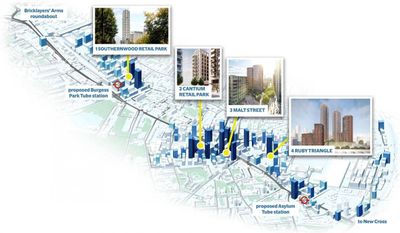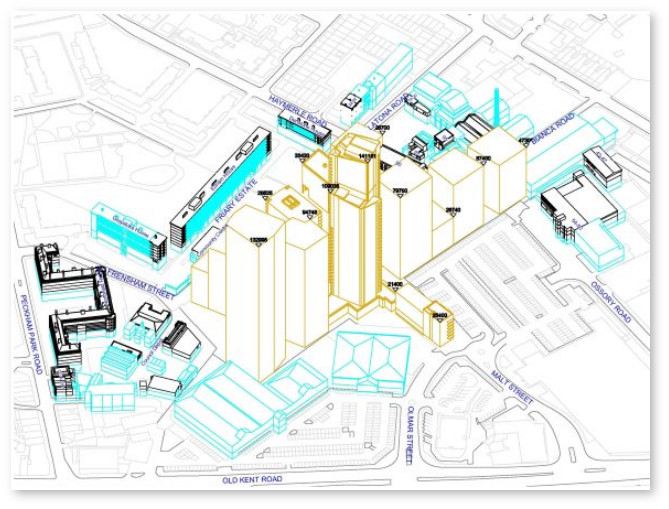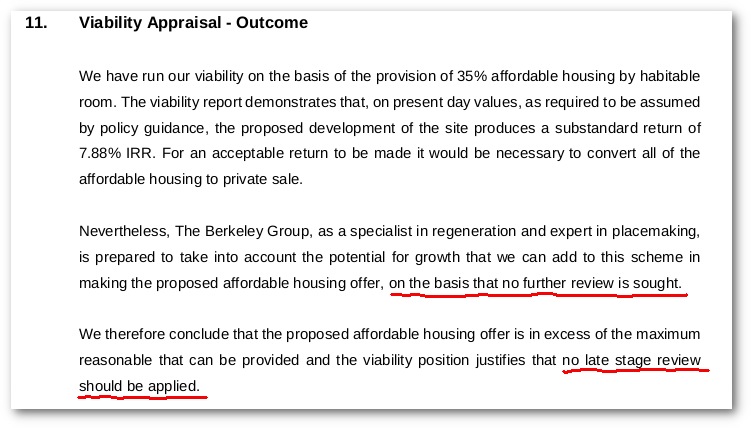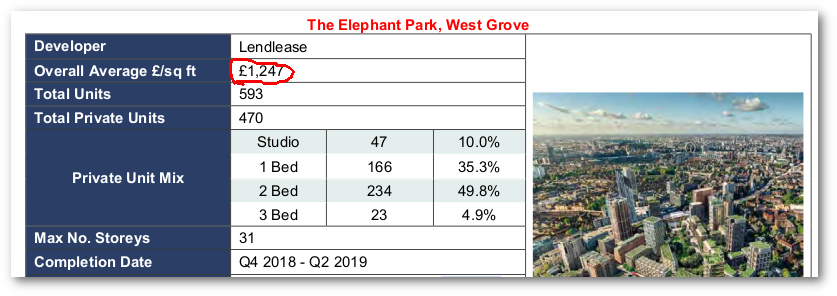
Southwark's planning committee is to consider yet another major Old Kent Rd development on Monday, the fourth so far, after Ruby Triangle, Cantium Retail park and Southernwood Retail Park. Southernwood was unanimously approved by Southwark's planning committee just last week, despite objections, including doubts about whether it that it will deliver the maximum reaonable amount of affordable housing. Serious concerns raised about the impact of the scheme on the proposed Bakerloo Line Extension (BLE), were allayed by a last minute letter to the Council from Transport for London (TfL).
For Malt St, Berkeley Homes proposes a mixed use development, including 1,300 homes and 7,000 sqm of commercial space, on 1.9 hectares of land behind Asda. It is a 'hybrid' application of two parts, a detailed application for 420 homes, and an outline application for 880 homes. The total development comprises 11 blocks, including 39 and 44 storey towers, to be built in three phases, with completion by 2027.
Berkeley Homes are offering 40% affordable housing in total across the whole scheme, with the detailed part of the scheme providing 83 social rented and 48 intermediate units, but leaving the exact number of affordable units provided by the outline part of the scheme to be determined later.

Taking the 'social' out of social rent?
As stated in the planning committee report, Berkeley propose 35% affordable housing, of which 25% would be social rent, 10% intermediate, with an additional 5% intermediate, supplied with the help of grant funding. However, the term 'social rent' does not appear anywhere throughout Berkeley's planning application, with the documents eg the viability assessment, using the term 'affordable rented' or just 'rent' instead.

Even the Mayor's Stage 1 planning report avoids using the term 'social rent' and instead describes the proposed tenure as 'low-cost rent' (para 33) . This is yet another affordable housing label, newly introduced by the Mayor's draft New London Plan, where it is defined to include London Affordable Rent, as well as social rent. The London Tenant's Federation has given evidence to the Mayor that there is a 43% difference between LAR and social rent, while the GLA has conceded during the Plan's public examination that there is a 14% difference between new build LAR and social rent.
The Malt St S106 draft heads of terms document says that the exact tenure of the affordable housing will not be decided until after the application is approved:

We have seen before promises of social rent do no not necessarily guarantee that social rent will be delivered and we are still waiting for the promised audit of affordable and social rented housing, after a damning ombudsman investigation, which found that Southwark had not monitored or enforced the tenure requirements of its s106 affordable housing agreements.
No late stage review
Berkeley Homes' viability assessment of the Malt St scheme says it will produce a 'substandard return' and it is technically unviable with 35% affordable housing (just as the developers of Ruby Triangle, Cantium Retail Park and Southernwood Retail did).
Southwark's consultant's agree with this analysis, albeit they calculate that the scheme is slightly less unviable than Berkeley claim. In any event, Berkeley offer 40% affordable housing on the understanding that the viability will be improved by better transport links (ie the Bakerloo Line Extension) and the ongoing regeneraation of the area. There is an important proviso, however - that there will be no late stage review.

This pre-empts any possibility that the amount of affordable housing will be raised to 50%, as required by the draft London Plan for Strategic Industrial land, such as the Malt St site - (the draft London Plan will be fully in force by the time Malt St is completed.)
Applications can avoid a late stage review, if they take the Mayor's Fast Track Route, by providing, 50% affordable housing, but the Mayor's planning report makes it clear this is not happening in this case:
"The application does not therefore follow the Fast Track Route with 35% affordable housing (as the threshold level would be 50% in this instance), and it must therefore be considered under the viability tested route." (paragraph 32)
A 35% Campaign objection on this point is appended to the end of this blogpost.
Viability assessment flaw
An important part of viability assessments is estimating a scheme's likely revenue. This is done by using 'comparables' ie the revenues other similiar schemes have realised. Berkeley Homes commissioned Savills for this task and they estimated an average sales value of completed homes of £776 per square foot.
 Extract from the Savills report in Berkeley's viability assessment (appendix 4a)
Extract from the Savills report in Berkeley's viability assessment (appendix 4a)
In arriving at this figure Savills uses Elphant Park (formerly the Heygate estate) where the sales are currently achieving £1,247 per sqft.

This is double the revenue estimate of £600 per sq ft Savills gave back in 2012, when it was commissioned for exactly the same task by Elephant Park developer Lendlease.
 Extract from the Savills report in Lendlease's viability assessment for Heygate estate redevelopment
Extract from the Savills report in Lendlease's viability assessment for Heygate estate redevelopment
The explanation for this big difference lies with the rule that viability assessments are based on current day values. This is a major problem in the viability testing method and is supposed to be mitigated by sensitivity analysis or scenario testing, where various increases in sales values are tested, but these tests are often inadequate. In the Heygate case the District Valuer Service, acting for Southwark, ran just one scenario, with a 5% increase in sales values, when the actual increase has proved to be just over 100%.
In the case of Malt St, Berkeley's hasn't done any scenario testing. The Council's independent review has done some, but only with a 5% increase in sales values. More comprehensive scenario testing should have been undertaken, for a major scheme such as this, likely to take a decade to complete and where values will be affected by such a major variable as the Bakerloo line extension.
In the absence of this the very least the Council should do is secure a late stage review, which should ensure that any great rise in values does not solely benefit the developer's profit, but is shared with local community, in the form of more affordable housing.
35% Campaign objection to no late stage review
"I am writing on behalf of the 35% Campaign to object to the recommended approval of planning application ref: 17/AP/2773.
The planning committee report for this application refers to the 40% affordable housing offer as exceeding the policy compliant level, stated as 35% (para 167). However, para 22 of the report also notes that the site is 'designated Strategic Industrial Land (SIL), in the London Plan'; as such, the draft New London Plan requires a higher, 50% level of affordable housing under Policy H6, Para B(3).
The planning committee report gives weight to the draft New London Plan and other emerging policy to justify the release of industrial land for residential and other development (para 145), in the first instance; therefore equal weight should be given to the 50% affordable housing requirement for housing built on such land and 50% affordable housing required.
Without 50% affordable housing the application fails to qualify for the draft London Plan's Fast Track route under the threshold approach to viability testing. Policy H6 is clear that applications that do not meet the 50% SIL threshold are subject to the viability tested route, which involves a Late Stage Viability review (Para E 2(b)). This is confirmed in the GLA Stage 1 report for the scheme (para 32), which states;

A late stage review should therefore be required if 50% affordable housing is not offered.
For these reasons and in the light of the Stage 1 report, we believe that the planning committee report is wrong when it states that the affordable housing offer 'exceeds the 35% GLA threshold level' and 're-provides the existing commercial floorspace' and that therefore there need be no late stage review (para 171). (NB Nothing in Policy H6 says that the 50% threshold for SIL locations can be avoided if existing commercial floorspace is re-provided).
As the application is a large phased development a mid-term review should also be required, according to Policy H6, Para E 2(c)."